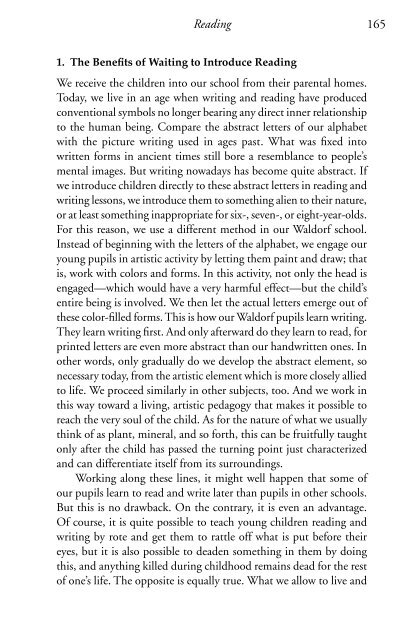Teaching Language arTs in The WaLdorf schooL
Teaching Language arTs in The WaLdorf schooL
Teaching Language arTs in The WaLdorf schooL
You also want an ePaper? Increase the reach of your titles
YUMPU automatically turns print PDFs into web optimized ePapers that Google loves.
Read<strong>in</strong>g<br />
165<br />
1. <strong>The</strong> Benefits of Wait<strong>in</strong>g to Introduce Read<strong>in</strong>g<br />
We receive the children <strong>in</strong>to our school from their parental homes.<br />
Today, we live <strong>in</strong> an age when writ<strong>in</strong>g and read<strong>in</strong>g have produced<br />
conventional symbols no longer bear<strong>in</strong>g any direct <strong>in</strong>ner relationship<br />
to the human be<strong>in</strong>g. Compare the abstract letters of our alphabet<br />
with the picture writ<strong>in</strong>g used <strong>in</strong> ages past. What was fixed <strong>in</strong>to<br />
written forms <strong>in</strong> ancient times still bore a resemblance to people’s<br />
mental images. But writ<strong>in</strong>g nowadays has become quite abstract. If<br />
we <strong>in</strong>troduce children directly to these abstract letters <strong>in</strong> read<strong>in</strong>g and<br />
writ<strong>in</strong>g lessons, we <strong>in</strong>troduce them to someth<strong>in</strong>g alien to their nature,<br />
or at least someth<strong>in</strong>g <strong>in</strong>appropriate for six-, seven-, or eight-year-olds.<br />
For this reason, we use a different method <strong>in</strong> our Waldorf school.<br />
Instead of beg<strong>in</strong>n<strong>in</strong>g with the letters of the alphabet, we engage our<br />
young pupils <strong>in</strong> artistic activity by lett<strong>in</strong>g them pa<strong>in</strong>t and draw; that<br />
is, work with colors and forms. In this activity, not only the head is<br />
engaged—which would have a very harmful effect—but the child’s<br />
entire be<strong>in</strong>g is <strong>in</strong>volved. We then let the actual letters emerge out of<br />
these color-filled forms. This is how our Waldorf pupils learn writ<strong>in</strong>g.<br />
<strong>The</strong>y learn writ<strong>in</strong>g first. And only afterward do they learn to read, for<br />
pr<strong>in</strong>ted letters are even more abstract than our handwritten ones. In<br />
other words, only gradually do we develop the abstract element, so<br />
necessary today, from the artistic element which is more closely allied<br />
to life. We proceed similarly <strong>in</strong> other subjects, too. And we work <strong>in</strong><br />
this way toward a liv<strong>in</strong>g, artistic pedagogy that makes it possible to<br />
reach the very soul of the child. As for the nature of what we usually<br />
th<strong>in</strong>k of as plant, m<strong>in</strong>eral, and so forth, this can be fruitfully taught<br />
only after the child has passed the turn<strong>in</strong>g po<strong>in</strong>t just characterized<br />
and can differentiate itself from its surround<strong>in</strong>gs.<br />
Work<strong>in</strong>g along these l<strong>in</strong>es, it might well happen that some of<br />
our pupils learn to read and write later than pupils <strong>in</strong> other schools.<br />
But this is no drawback. On the contrary, it is even an advantage.<br />
Of course, it is quite possible to teach young children read<strong>in</strong>g and<br />
writ<strong>in</strong>g by rote and get them to rattle off what is put before their<br />
eyes, but it is also possible to deaden someth<strong>in</strong>g <strong>in</strong> them by do<strong>in</strong>g<br />
this, and anyth<strong>in</strong>g killed dur<strong>in</strong>g childhood rema<strong>in</strong>s dead for the rest<br />
of one’s life. <strong>The</strong> opposite is equally true. What we allow to live and

















